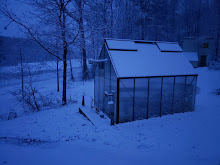Killer Trees and Hope
Riding in the woods gives me yet another chance to ogle trees. I spend as much time observing trees as most do watching television.
After you have watched the same community of trees for thirty years or so, you start to notice things like the fact that maples are vicious. They set into a lime ledge and wedge with their roots until they rive off boulders the size of a Holstein calf just to make themselves a little room. They insinuate themselves up alongside a white pine, stealing the light and gaining steadily until the pine gives up and falls over. The wrap themselves around the base of other species and strangle them.
A forest over time can take out anything we can build. I have been watching a twelve foot steel wire fence around a defunct local reservoir as it gets laid on its side by various falling boles, then covered by leaves and sticks. If you dig into the organic cover after as little as a decade, the wire's rusted and brittle, snapped easily between fingertips. In fifty years it won't be there in any casually recognizable form.
These and other observations give me hope that, when we have completed our poisoning of our own nest, there is some hope, there is in fact certainty of recovery in some satisfying form.
After you have watched the same community of trees for thirty years or so, you start to notice things like the fact that maples are vicious. They set into a lime ledge and wedge with their roots until they rive off boulders the size of a Holstein calf just to make themselves a little room. They insinuate themselves up alongside a white pine, stealing the light and gaining steadily until the pine gives up and falls over. The wrap themselves around the base of other species and strangle them.
A forest over time can take out anything we can build. I have been watching a twelve foot steel wire fence around a defunct local reservoir as it gets laid on its side by various falling boles, then covered by leaves and sticks. If you dig into the organic cover after as little as a decade, the wire's rusted and brittle, snapped easily between fingertips. In fifty years it won't be there in any casually recognizable form.
These and other observations give me hope that, when we have completed our poisoning of our own nest, there is some hope, there is in fact certainty of recovery in some satisfying form.

1 Comments:
I picked up a book at the library yesterday about the naval stores industry in the South -- not a likely choice for me except that I'm lately obsessed with the word "tap" and the title was "Tapping the Pines" -- it's about the survivalist longleaf pine, which once it reaches a certain size has half-inch to three-quarter-inch thick bark that will resist burning when the rest of the forest goes, and from this pine comes tar, pitch, turpentine, and resin. Am at the very beginning of the book. The author claims this is why NC is called the "Tar Heel" state.
Post a Comment
<< Home